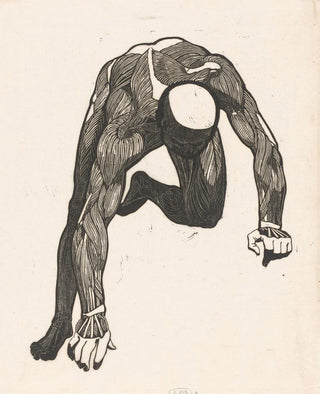Art print | Anatomical study of the muscles of the neck, arms, and legs of a man - Reijer Stolk


View from behind

Frame (optional)
In the fascinating universe of art, some works stand out for their ability to capture the very essence of the human condition. "Anatomical study of the muscles of the neck, arms, and legs of a man" by Reijer Stolk is a striking example. This piece, beyond its function as a study, sparks in us a deep reflection on the beauty of the human body and the complexity of its structure. Through this art print, the viewer is invited to immerse themselves in a world where art and science meet, revealing a unique vision of human anatomy that is both precise and aesthetic.
Style and uniqueness of the work
Stolk's style is characterized by a meticulous and detailed approach, demonstrating undeniable technical mastery. Every muscle, every tendon is depicted with surgical precision, reflecting the artist's rigorous observation. The composition of the piece, although focused on anatomy, exudes a certain harmony, almost poetic. The flowing lines and delicately worked shadows create a dynamic that transcends simple anatomical drawing. The artist manages to bring his subject to life, transforming a scientific study into a full-fledged work of art. This marriage of scientific rigor and artistic sensitivity makes this piece a singular work, inviting contemplation and admiration.
The artist and his influence
Reijer Stolk, though less known than some of his contemporaries, has left an indelible mark on the art world. His work, often focused on themes of anatomy and morphology, reflects an insatiable curiosity about the human body and its mysteries. Influenced by the great masters of the Renaissance, he was able to incorporate elements of their style while developing his own voice. Stolk has not only contributed to the advancement of artistic anatomy but has also inspired many artists who followed in his footsteps, seeking to explore the beauty and complexity of the human body through their own lens. His legacy endures, and his works continue to be studied and admired for their depth and precision.

Matte finish

View from behind

Frame (optional)
In the fascinating universe of art, some works stand out for their ability to capture the very essence of the human condition. "Anatomical study of the muscles of the neck, arms, and legs of a man" by Reijer Stolk is a striking example. This piece, beyond its function as a study, sparks in us a deep reflection on the beauty of the human body and the complexity of its structure. Through this art print, the viewer is invited to immerse themselves in a world where art and science meet, revealing a unique vision of human anatomy that is both precise and aesthetic.
Style and uniqueness of the work
Stolk's style is characterized by a meticulous and detailed approach, demonstrating undeniable technical mastery. Every muscle, every tendon is depicted with surgical precision, reflecting the artist's rigorous observation. The composition of the piece, although focused on anatomy, exudes a certain harmony, almost poetic. The flowing lines and delicately worked shadows create a dynamic that transcends simple anatomical drawing. The artist manages to bring his subject to life, transforming a scientific study into a full-fledged work of art. This marriage of scientific rigor and artistic sensitivity makes this piece a singular work, inviting contemplation and admiration.
The artist and his influence
Reijer Stolk, though less known than some of his contemporaries, has left an indelible mark on the art world. His work, often focused on themes of anatomy and morphology, reflects an insatiable curiosity about the human body and its mysteries. Influenced by the great masters of the Renaissance, he was able to incorporate elements of their style while developing his own voice. Stolk has not only contributed to the advancement of artistic anatomy but has also inspired many artists who followed in his footsteps, seeking to explore the beauty and complexity of the human body through their own lens. His legacy endures, and his works continue to be studied and admired for their depth and precision.






